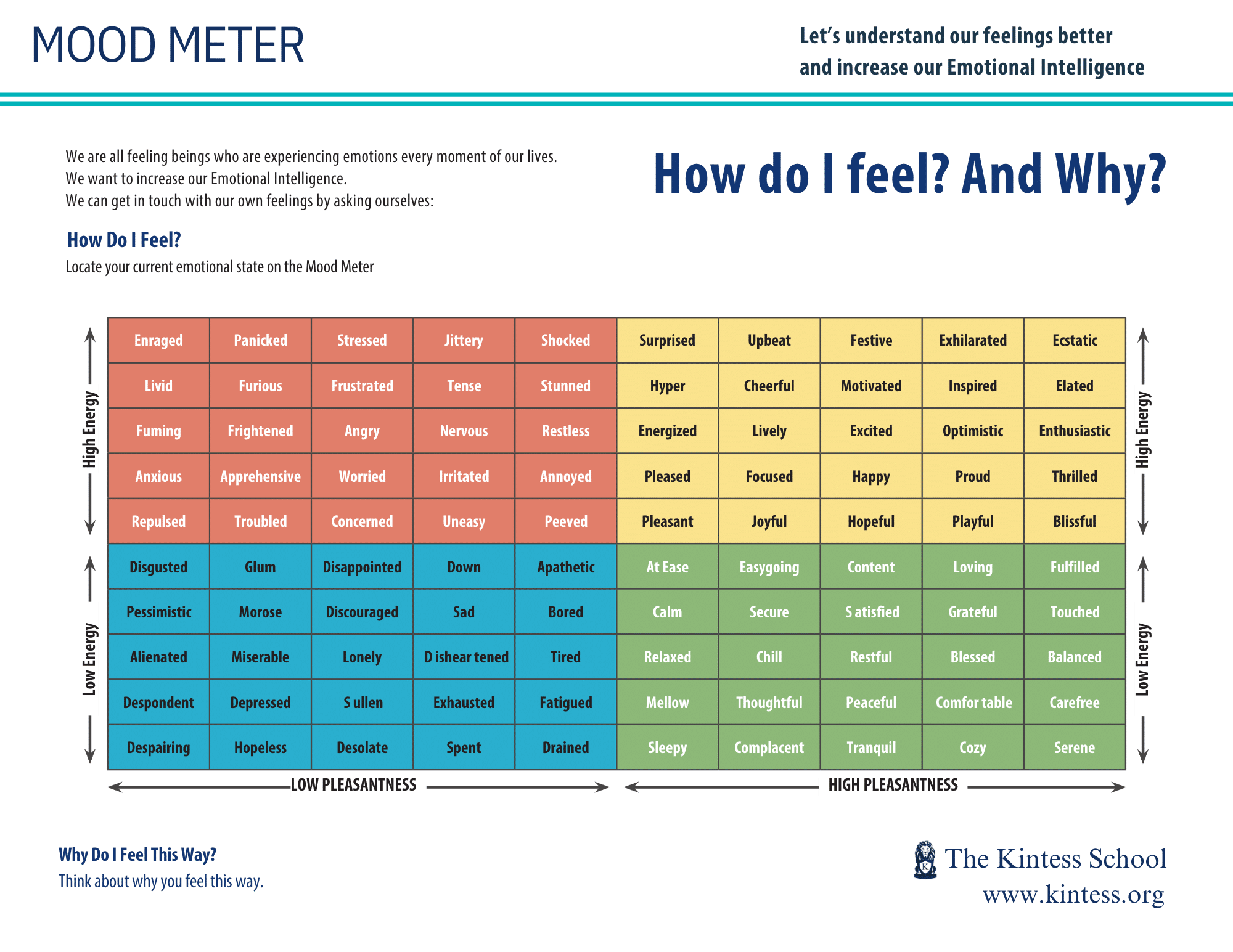Understanding Emotions with the Mood Meter

At the Kintess School, we believe emotional intelligence is just as important as academic success. That’s why we integrate the Mood Meter, a key tool from the RULER method, into our students’ daily learning experiences. By helping students identify and regulate their emotions, we set them up for success in academics, social interactions, and personal growth.
Understanding emotions can improve decision-making, relationships, communication, and well-being. The Mood Meter is a simple but powerful tool that helps students—and even parents—become more aware of their emotions and how they affect their daily lives.
What Is the Mood Meter?
The Mood Meter is a scientifically backed emotional awareness tool developed by researchers at the Yale Center for Emotional Intelligence. It categorizes emotions based on two key dimensions:
- Energy Levels – Does the emotion feel high energy or low energy?
- Pleasantness – Is the emotion pleasant or unpleasant?
By mapping emotions along these two dimensions, the Mood Meter divides feelings into four color-coded quadrants:
🟡 Yellow Quadrant: High Energy, Pleasant Emotions
Yellow emotions include joy, excitement, enthusiasm, and optimism. These are the emotions that fuel collaboration, teamwork, and creative problem-solving.
When students are in the yellow quadrant, they tend to be more socially engaged, energetic, and eager to participate. Class discussions, group projects, and brainstorming sessions thrive when students experience these emotions.
🔹 Example: A student feels excited about a group science experiment and actively participates, exchanging ideas.
🟢 Green Quadrant: Low Energy, Pleasant Emotions
Green emotions include calmness, relaxation, satisfaction, and gratitude. These feelings create an ideal state for self-reflection, mindfulness, and consensus-building.
In the classroom, green emotions help students engage in deep thinking, self-awareness, and open discussions. These emotions foster diplomacy and collaboration, making them essential for teamwork and conflict resolution.
🔹 Example: A student in the green quadrant listens to classmates’ perspectives in a debate and helps find common ground.
🔵 Blue Quadrant: Low Energy, Unpleasant Emotions
Blue emotions include sadness, disappointment, loneliness, and fatigue. While these feelings may seem negative, they play a crucial role in critical thinking, problem-solving, and self-improvement.
When students experience blue emotions, they tend to be introspective and analytical. This makes them more likely to ask deeper questions, reflect on their mistakes, and find solutions.
🔹 Example: A student receives constructive feedback on an essay and, rather than feeling discouraged, revises and improves their work.
🔴 Red Quadrant: High Energy, Unpleasant Emotions
Red emotions include anger, frustration, anxiety, and stress. These feelings often arise in challenging situations, such as competitive activities, high-pressure tasks, or moments of conflict.
While red emotions can feel overwhelming, they also serve an important purpose. They motivate action, fuel competition, and push students to overcome obstacles. In healthy doses, these emotions build resilience and determination.
🔹 Example: A student feels frustrated before a math test but uses this energy to focus and prepare.
How Kintess Uses the Mood Meter in Education
At Kintess, we incorporate the Mood Meter into daily learning. This helps students become more aware of their emotions, understand how feelings impact their learning, and develop strategies to regulate their moods.
Here’s how we integrate the Mood Meter into the classroom:
1. Daily Check-ins with the Mood Meter
Every morning, students identify where they are on the Mood Meter. This helps them start the day with emotional awareness and allows teachers to adjust lessons based on the class’s emotional climate.
🔹 Example: If many students feel blue (tired or unmotivated), the teacher may start the lesson with an engaging activity to energize them.
2. Emotional Discussions & Social Learning
Students share their emotions and discuss how they influence behavior. These conversations help build empathy and social awareness, essential life skills for personal and academic success.
🔹 Example: A student feeling red (frustrated) after a difficult test might talk about it, and classmates might offer strategies for dealing with stress.
3. Emotional Regulation Strategies
Once students recognize their emotions, they learn techniques to shift into a more productive state.
- Feeling too excited? (Yellow → Green) → Try deep breathing or journaling.
- Feeling frustrated? (Red → Green) → Take a short walk or listen to calming music.
- Feeling sad? (Blue → Yellow) → Engage in a fun activity or talk to a friend.
4. Connecting Emotions to Learning Styles
Different emotions impact how students learn.
- Yellow quadrant students work best in collaborative projects and brainstorming.
- Green quadrant students excel in self-paced learning and reflection.
- Blue quadrant students thrive in critical thinking and independent study.
- Red quadrant students perform well in competitive activities like debates or sports.
By using the Mood Meter, students understand their emotions and adjust their approach to learning.
Find Out How You Feel – Download the Mood Meter
The Mood Meter isn’t just for students—it’s for everyone! Recognizing emotions can help anyone become more mindful, self-aware, and emotionally intelligent.
Download the Mood Meter today and start tracking how you feel throughout the day.

By using the Mood Meter, you can better understand your emotions, identify patterns, and develop strategies to stay balanced and productive.
For Parents – Mood Meter Merchandise
Parents play a key role in supporting emotional learning at home. We offer Mood Meter-related resources to help families practice emotional intelligence together.
🛒 Shop Mood Meter Resources for Parents
Using the Mood Meter at home can:
✅ Help kids express their feelings more openly
✅ Improve parent-child communication
✅ Reduce stress and conflict
✅ Teach valuable emotional regulation skills
At the Kintess School, we believe emotional learning is the foundation for lifelong success. By incorporating the Mood Meter in school and at home, we help students develop the skills they need to thrive in all areas of life.